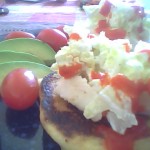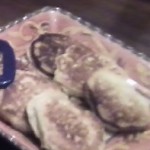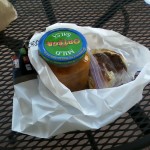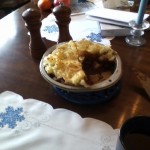Basic French Bread Recipe
 This is a basic “water dough,” meaning its main ingredients are flour, yeast and water. This makes a great, crisp bread, but the absence of oil also means it may go stale more quickly. This can be formed into the traditional long skinny bagguettes, the shorter rounder boule, thick long italian loafs, or small petite pain or brötchen.
This is a basic “water dough,” meaning its main ingredients are flour, yeast and water. This makes a great, crisp bread, but the absence of oil also means it may go stale more quickly. This can be formed into the traditional long skinny bagguettes, the shorter rounder boule, thick long italian loafs, or small petite pain or brötchen.
Ingredients:
3 cups warm water
a pinch of sugar (optional, oh ye of little faith)
2 Tbsp. Yeast (maybe 3 envelopes?)
1Tbsp. Salt
7 cups, give or take, of bread flour (6+ cups); Yeah, yeah, I don’t have an exact amount because there isn’t an exact amount–I live in a very humid, even damp, part of the country, if you are actually dry, you will need less flour.
Possibly a bit of olive oil, corn meal and vinegar as tools for the preparation.
A note on flour: Although I am casual about what flour you use on other breads, I strongly recommend King Arthur Bread Flour. Imitating European bread requires a flour that imitates European flour. European flour comes from a specific type of hard red wheat which is easier to grow in New England because of the similar climate and latitude.
Step 1, Proofing: Put the first 2 cups of hot water in a large bowl (or the mixer bowl if you plan on letting the bread hook to do the heavy lifting). This can actually be hot, since it will warm the bowl, and since there are several things which will go on before it comes in contact with the yeast. In a 1 1/2 or 2 cup pyrex measruing cup or a mason jar, add one cup of warm water, a pinch of sugar (the yeast actually can get its sugar from the flour, so this isn’t necessary, but I have trust issues), and whisk until the sugar is disolved. Add the 2 Tbsp. of Yeast and whisk until smooth. Set aside.
Step 2, Adding flour: Return to the other bowl and whisk the salt into the 2 cups of water. Slowly sift–yes, sift–in the first 2 cups of flour–whisking in each 1/2 cup until it is smooth. By the time this batter–and the consistency will be like a batter–is starting to get stiff, the yeast mixture should have strted foaming up, and might be about to overflow. Add the yeast mixture to the flour mixture and whisk until smooth Sift in another cup or so of flour a little at a time, until the mixture is almost too thick for the whisk. At this point, take out the whisk and leave this in a warm place for 5 minutes and walk away. Fold laundry, have a glass of wine, play with the dog, try to figure out where you put the rest of the bread flour, dance, just leave the yeast alone.
Step 3, Kneading: Come back to Erin, Mavourneen, Mavourneen. If it is bigger, and a little poofy, the yeast is doing great. If not, either you have bad yeast or a cold spot. Continue to sift in the Bread Flour 1/4 of a cup at a time, and thoroughly mix it in; at this point, I would be using a big wooden spoon, when this is too hard, use a mixer with a bread hook or turn it our onto a floured surface.
It is important to knead the flour in 1/4 of a cup at a time, and after each bit of flour, hook or knead the bread until it becomes one thing again–not a mixture of flour and dough, but one unit. When the dough is a single round thing holding on to itself and not sticking to other things, behaving about like a deflated volley ball, it is ready. Until the sandwich laves, the doaugh should still be a little sticky, but it should be a ball that feels sticky, not doough that leaves the group , breaks apart, and sticks to your hands in large globs. The amount of the flour doesn’t matter–getting it to this proper consistency is what matters. Roll it around on the counter for good measure.
Step 4, Rising: Grease a smooth bowl 3 times as big as the dough. Roll the dough ball in the oil, and then cover with plastic wrap or a wet towel or something that will let it slip without drying out. Let this sit in in a warm place–in the oven with a heating pad on a different shelf, on the sunny side of the house, just a safe and warm place–until the dough has doubled in size. Usually, this will be about an hour.
Step 4, Second Rising: Turn the dough out onto a clean surface, and punch it down (forcefully knead it), which should reduce it to close to its original size. Separate this into 3 portions ( or 4 or… you figure it out) and shape these into loaves; make sure that there are not seams or spots the loaf might separate, maybe pinching loose edges and rolling it about a bit–each should be smooth and coherent–it’s own little self.
Step 5, Second Rising: Prepare baking sheets for the loaves you have just formed. If the sheets have a good non-stick surface like my bagguette pans, just spray with a little bit of oil, or, on a baking sheet, you can spray a little bit of oil the size of each loaf and sprinkle a bit of corn meal. Put each loaf onto a baking sheet, cut crossways slits along the top with a sharp knife (this lets bubbles out) and set these into a warm place until they have grown–usually less that the first rise. about half way through this rise (20? 25 minutes?) pre-heat the oven to 450 degrees.
Step 6, Baking: Just before putting them in the oven, I usually spary a light misting of vinegar on the outside of each loaf. This adds to the crunchiness of the crust. You can also add a little pan of water to the bottom of the oven, since the steam will also make the crust crustier. Put the loaves in the oven for 15 minutes, rotate them, putting bread from the lower racks onto the top, turning the backs to the front, etc.until the top crust is a nice dark brown. figure out your oven, and see if you need to turn them or rotate them to get them to cook evenly. When they are done, get them out, take them out of the pans, and put them on a cooling rack.
If everything has gone well, they should smell as golden as all that is right about the material world, and about a minute later you shoulod be able to hear la chanson du pain, the song of the bread, that tinkling little cracking noise as the bread cools.
Last Step, Sharing: This one should be shared quickly. You should share one loaf with 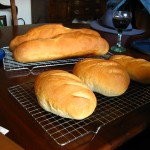 a warm loved one and some cold butter before it even cools. Another loaf will be perfect with some olive oil and pasta and salads and a rich Chianti for supper. a little loaf will be perfect with some sharp cheddar, a hard boiled egg, a whole tomato, a dill pickle and some branston pickle for a plow-man’s lunch at work. Most importantly, if you have extra bread, you will have to give it away, but–with this bread–quickly. It is perfect with a bottle of wine as a house warming gift or in lieu of a condolence card for seomone who has lost a loved one, or to hang on a door knob for a friend to find when they get home from work, or for the host for the evenings vespers, or to share with a college student or wandering monk.
a warm loved one and some cold butter before it even cools. Another loaf will be perfect with some olive oil and pasta and salads and a rich Chianti for supper. a little loaf will be perfect with some sharp cheddar, a hard boiled egg, a whole tomato, a dill pickle and some branston pickle for a plow-man’s lunch at work. Most importantly, if you have extra bread, you will have to give it away, but–with this bread–quickly. It is perfect with a bottle of wine as a house warming gift or in lieu of a condolence card for seomone who has lost a loved one, or to hang on a door knob for a friend to find when they get home from work, or for the host for the evenings vespers, or to share with a college student or wandering monk.

